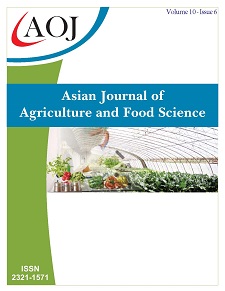Effects of Rice Combine Harvester on Postproduction Losses and Production Costs: The Case of Luzon, Philippines
DOI:
https://doi.org/10.24203/ajafs.v10i6.7100Keywords:
Postproduction losses, Production cost, Rice combine harvesterAbstract
This study quantified the effects of rice combine harvester (RCH) on rice output particularly on harvesting-threshing losses and production costs. The postproduction losses using different models of RCH were established following a randomized complete block design with two replications and these were compared with the traditional method of harvesting and threshing rice. Partial budget analysis was employed to determine the benefits derived by farmer-adopters using the data gathered from a one-shot cross sectional survey involving 448 respondents. Results of the field experiments revealed that postproduction losses with the three models of RCH did not differ significantly, ranging from 1.19% to 1.76% of the total yield. Comparing the harvesting-threshing losses in using RCH and the traditional method, the use of RCH significantly reduced harvesting-threshing losses by 1.02 percentage points. Prevention of postharvest loss was more pronounced during the wet season harvest at 1.54 percent. From the point of view of the farmer-adopters, the use of RCH lowered harvesting costs by PhP 3,908.60/ha/ and gained additional PhP 718.40/ha for losses prevented by using RCH. Thus the farmer-adopter could potentially gains additional benefit of PhP 4,627.00/ha/cropping season. With these, the use of RCH has the potential to enhance rice competitiveness by lowering the production cost and preventing paddy loss by PhP1.12/kg or 9.56% of the current production cost.
References
ALIZADEH, M.R. and A. ALLAMEH. 2013. Evaluating Rice Losses in Various Harvesting Practices. International Journal of Sciences: Basic and Applied Research. 4(4):894-901. Retrieved on November 26, 2018 at https://www.researchgate.net/publication/ 267208222_Evaluating Rice_Losses_in_Various_Harvesting_Practices.
AMARASINGHE, M.N. and G.C. SAMARAWEERA. 2010. Economic Impacts of Using Combine Harvesters in Paddy Cultivation in Hambantota District, Sri Lanka. Proceedings of the 8th Academic Sessions, University of Ruhuna. Vol. 8. Retrieved on November 26, 2018 from www.ruh.ac.lk/research/academic_sessions/2011_mergepdf/p4.pdf
BORDEY, F.H., J.C. BELTRAN, C.C. LAUNIO, A.C. LITONJUA, A.B. MATAIA, R.G. MANALILI and P.F. MOYA. 2016a. Rice Yield and its Determinants. In Competitiveness of Philippine Rice in Asia. Bordey FH, Moya PF, Beltran JC, Dawe DC editors. Science City of Muñoz (Philippines): Philippine Rice Research Institute and Manila (Philippines): International Rice Research Institute.
MAHROUF, A.R.M. and M.I.M RAFEEK. 2003. Mechanization of Paddy Harvesting: The Economic Perspective. Socio-Economics and Planning Center, Peradeniya, Sri Lanka.
MALANON, H.G. and R.SM. DELA CRUZ. 2018. On-farm Mechanization of Paddy in the Philippines. Asian Journal of Postharvest and Mechanization. 1(1). Philippine Center for Postharvest and Mechanization (PHilMech). CLSU Cmpd., Science City of Muñoz, Nueva Ecija, Philippines.
MARANAN, C.L., R.R. PAZ and R.S. RAPUSAS. 1996. National Postproduction Loss Assessment for Rice and Corn. Terminal Report. Bureau of Postharvest Research and Extension. Science City of Munoz, Nueva Ecija.
Philippine National Standard. 2015. Philippine Agricultural Engineering Standard. PNS/PAES 205:2015. Agricultural Machinery – Mechanical Rice Thresher-Methods of Test. Retrieved on November 30, 2018 at https://amtec.uplb.edu.ph/images/2015PAES/PNSPAES205_2015AgriculturalMachineryMechanicalRiceThresherMethodsofTest.pdf
Philippine National Standard. 2015. Philippine Agricultural Engineering Standard. PNS/PAES 225:2015. Agricultural Machinery-Rice Combine Harvester-Methods of Test. Retrieved on November 30, 2018 at https://amtec.uplb.edu.ph/images/2015PAES/PNSPAES225_2015AgriculturalMachineryRiceCombineHarvesterMethodsofTest.pdf
SALVADOR, A.R., D.R. MIRANDA, V.E. CAMASO, R.Q. GUTIERREZ and R.R. PAZ. 2010. Assessment of the State and Magnitude of the Paddy Grains Postproduction Losses in Major Rice Production Areas. Philippine Center for Postharvest Development and Mechanization. Science City of Muñoz, Nueva Ecija.
SATTAR, M., M, DIN, M.ALI, L. ALI, M. Q. WAQAR, M.A. ALI and L. KHALID. 2015. Grain Losses of Wheat as Affected by Different Harvesting and Threshing Techniques. Int. Jour. of Research in Agriculture and Forestry. 2(6)
Downloads
Published
Issue
Section
License
Copyright (c) 2023 Hernaiz G. Malanon, Renita SM. Dela Cruz

This work is licensed under a Creative Commons Attribution-NonCommercial 4.0 International License.
- Papers must be submitted on the understanding that they have not been published elsewhere (except in the form of an abstract or as part of a published lecture, review, or thesis) and are not currently under consideration by another journal published by any other publisher.
- It is also the authors responsibility to ensure that the articles emanating from a particular source are submitted with the necessary approval.
- The authors warrant that the paper is original and that he/she is the author of the paper, except for material that is clearly identified as to its original source, with permission notices from the copyright owners where required.
- The authors ensure that all the references carefully and they are accurate in the text as well as in the list of references (and vice versa).
- Authors retain copyright and grant the journal right of first publication with the work simultaneously licensed under a Attribution-NonCommercial 4.0 International that allows others to share the work with an acknowledgement of the work's authorship and initial publication in this journal.
- Authors are able to enter into separate, additional contractual arrangements for the non-exclusive distribution of the journal's published version of the work (e.g., post it to an institutional repository or publish it in a book), with an acknowledgement of its initial publication in this journal.
- Authors are permitted and encouraged to post their work online (e.g., in institutional repositories or on their website) prior to and during the submission process, as it can lead to productive exchanges, as well as earlier and greater citation of published work (See The Effect of Open Access).
- The journal/publisher is not responsible for subsequent uses of the work. It is the author's responsibility to bring an infringement action if so desired by the author.


